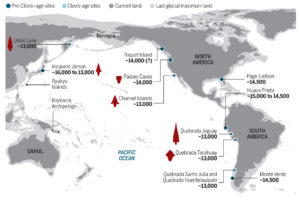 This very interesting Perspectives article was published in the 3 November 2017 issue of Science magazine. I have linked the PDF of the article here and the main figure is included so you can see the general hypothesis. This has been called the kelp highway hypothesis and the authors state that most archaeologists as well as scholars in other disciplines now think that the earliest Americans followed the shorelines along the Pacific Rim. This has become known as the kelp highway because the evidence for it would have been submerged by increases in sea levels occurring since the last glacial maximum, about 26,500 years ago.
This very interesting Perspectives article was published in the 3 November 2017 issue of Science magazine. I have linked the PDF of the article here and the main figure is included so you can see the general hypothesis. This has been called the kelp highway hypothesis and the authors state that most archaeologists as well as scholars in other disciplines now think that the earliest Americans followed the shorelines along the Pacific Rim. This has become known as the kelp highway because the evidence for it would have been submerged by increases in sea levels occurring since the last glacial maximum, about 26,500 years ago.
In the Straw Sandals Project, we are beginning to understand how the geographical clustering of sandal construction methods, obvious from the first phylogenetic or similarity trees that we made, can follow the ancient migration routes of humans, determined by genetic methods and also by linguistic studies of the relationships among the world’s languages.
How ancient peoples reached the shores of the Americas is still an open question the subject of debate. There are many supporters of the Beringia land bridge route and this is the one shown in the figure in this article. Another option, ancient Americans may have reached our shores on boats and rafts, traveling west to east, has also received interest. Of course, both routes may have been used.